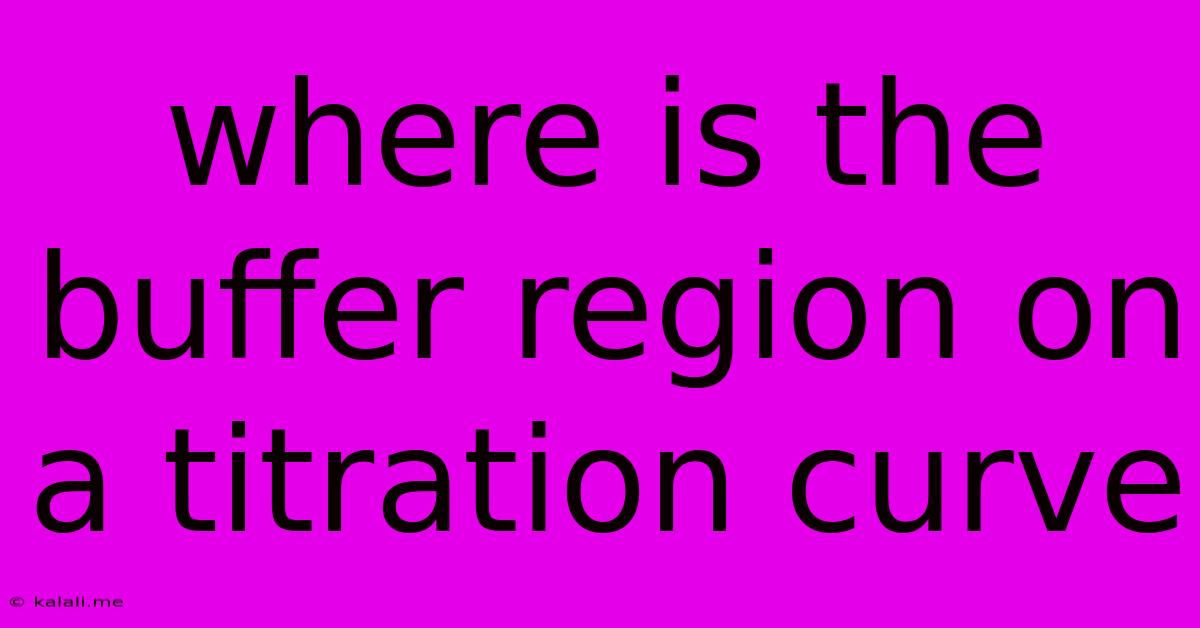Where Is The Buffer Region On A Titration Curve
Kalali
Jun 16, 2025 · 3 min read

Table of Contents
Where is the Buffer Region on a Titration Curve?
Meta Description: Understanding titration curves is crucial in chemistry. This article clearly explains how to identify the buffer region on a titration curve, focusing on the key indicators and its significance.
Titration curves are graphical representations of the change in pH during an acid-base titration. They're incredibly useful for determining the equivalence point and understanding the buffering capacity of a solution. But one particularly important feature is the buffer region, and knowing where to find it is key to interpreting the titration data.
What is a Buffer Region?
A buffer solution resists changes in pH upon the addition of small amounts of acid or base. This resistance is due to the presence of a weak acid and its conjugate base (or a weak base and its conjugate acid). The buffer region on a titration curve corresponds to the portion where the solution exhibits this buffering capacity. It's characterized by a relatively flat, gradual slope.
Identifying the Buffer Region on a Titration Curve:
The buffer region is typically found before the equivalence point in a titration. Specifically, look for these characteristics:
-
Mild Slope: The most prominent feature. The pH changes only slightly with the addition of significant amounts of titrant. This indicates the solution's resistance to pH change – the defining characteristic of a buffer.
-
Midpoint of the Buffer Region: The exact middle of the relatively flat region represents the solution's point of maximum buffering capacity. At this point, the concentrations of the weak acid and its conjugate base (or weak base and its conjugate acid) are roughly equal. This is also known as the pKa (or pKb) of the weak acid (or base). The pH at this midpoint is numerically equal to the pKa (or pKb).
-
Range: The buffer region typically extends approximately one pH unit above and below the pKa (or pKb). This range signifies the effective buffering capacity. Outside this range, the solution's ability to resist pH changes diminishes significantly.
-
Comparison to Strong Acid/Base Titrations: To truly appreciate the buffer region, compare it to a strong acid-strong base titration curve. A strong acid-strong base titration exhibits a sharp, almost vertical change in pH near the equivalence point; there is no noticeable buffer region.
Why is Identifying the Buffer Region Important?
Identifying the buffer region is vital for several reasons:
-
Understanding Buffer Capacity: It reveals the range of pH over which the solution effectively resists pH changes. A wider buffer region indicates a higher buffering capacity.
-
Selecting Appropriate Buffers: Knowing the pKa of a weak acid helps in choosing the right buffer for a specific pH range in various applications, from biological experiments to industrial processes.
-
Analyzing Titration Data: Accurately locating the buffer region allows for more precise determination of the equivalence point and the pKa/pKb of the weak acid/base.
Example: Acetic Acid Titration
Imagine titrating acetic acid (a weak acid) with a strong base like sodium hydroxide. The titration curve would show a gradual increase in pH initially, representing the buffer region. As more base is added, the pH increases more rapidly, indicating the approach to and passing of the equivalence point.
In summary, the buffer region on a titration curve is a crucial indicator of a solution's ability to resist pH changes. By understanding its characteristics and location, you gain valuable insights into the behavior of buffer solutions and improve the analysis of titration data. Remember to always look for the relatively flat, gradual slope preceding the equivalence point to pinpoint this significant region.
Latest Posts
Latest Posts
-
How To Create Clickable Image In Html
Jun 16, 2025
-
What Are The Factors Of 121
Jun 16, 2025
-
What Is A Theme Of The Passage
Jun 16, 2025
-
A Company That Provides Access To The Internet
Jun 16, 2025
-
Which Word Is Closest In Meaning To The Underlined Word
Jun 16, 2025
Related Post
Thank you for visiting our website which covers about Where Is The Buffer Region On A Titration Curve . We hope the information provided has been useful to you. Feel free to contact us if you have any questions or need further assistance. See you next time and don't miss to bookmark.